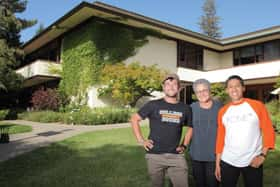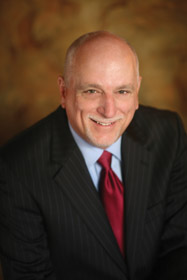"Let us remember: One book, one pen, one child and one teacher can change the world."—Malala Yousafzai
 Sometimes, all it takes is one: one business owner offering a first job, one teacher giving encouragement, one college awarding a scholarship.
Sometimes, all it takes is one: one business owner offering a first job, one teacher giving encouragement, one college awarding a scholarship.
One opportunity can change the course of a person’s whole life. But how do we ensure that every student who’s willing to work hard has access to those kinds of opportunities, regardless of financial circumstances, racial prejudices or the low expectations of others? For nearly 19,000 young people, the answer has been 10,000 Degrees.
10,000 Degrees is a Marin and Sonoma county-based nonprofit that works from the simple premise that all students have the right to educational opportunity. The organization started life 1981 as Marin Education Fund, originally acting a technical scholarship processing center and resource library for those seeking for college and career assistance. In 2000, the staff and board members dramatically transformed its mission, reaching into the community and focusing its efforts on serving students from low-income households. It expanded to Sonoma County in 2009 in response to overwhelming requests from parents and schools and has since opened an office in Santa Rosa.
Today, 10,000 Degrees serves more than 4,500 students per year at all Marin County high schools, six Sonoma County high schools and 1,100 attending college. No minimum grade point averages or SAT scores are required. Ninety percent of participants are the first in their families to attend college and 87 percent are from communities of color. The average 10,000 Degrees family earns $24,000 per year for a family of four.
“Data shows the only thing that’s really going to break the cycle of poverty is a college degree,” says Kim Mazzuca, president/CEO of 10,000 Degrees. “We’re not saying a four-year degree fits all. We’re saying every student deserves the choice. Many students leave high school today without real choice because they’re not prepared to access post-secondary options.”
To understand this, it’s first important to note that in many school districts, high school graduation requirements are different than the requirements to enter a California state University (CSU) or University of California (UC), also known as the “A-G requirements.” Getting into college isn’t simply a matter of getting good grades, but also of understanding these requirements and planning their course loads from ninth grade on to ensure requirements are met on time; they need the information, guidance and financial resources to access higher education. At best, school counselors with large caseloads can miss a student who could be eligible for college if encouraged to add another year of math or science. At worst, counselors may assume a student isn’t “college material” and never offer the necessary information about college preparation.
“Teachers and counselors, as much as they believe in some students, don’t believe in all students,” says Mazzuca. “They don’t hold all students to the same level of expectation. Our students hear it all the time, and it needs to change.”
Add students who assume college is financially out of reach, and families unfamiliar with how to navigate college admissions, and you begin to see why extra support is so critical.
College access and college success
10,000 Degrees focuses on supporting students in two main areas: college access and college success. It currently offers some programming for elementary and middle school students, but most students are introduced to 10,000 Degrees during a summer intensive program before their junior year of high school. During these free weeklong programs, held on local college campuses, 50 students sleep in dormitories and take classes on SAT and college preparation, financial aid, writing and team building. They also begin to see themselves as potential college students, sometimes for the first time. This summer’s four intensive programs will run at University of San Francisco, Sonoma State University in Rohnert Park and St. Mary’s College in Moraga.
After completing the program, students go back to their high schools and can apply to be student leaders. Ten to 12 students are chosen for each school served, and their job is to inform their peers know about the program and share what they’ve learned with other students. During the next two years, students attend workshops and tutoring sessions at the organization’s offices and their high school, tour college campuses together and can be paired with a volunteer mentor. They also form bonds with other students facing similar challenges.
“Students learn what to expect and how to advocate for themselves,” says Mazzuca. “We help them apply to colleges and for financial aid, and to choose the right college for them and their families.”
10,000 Degrees also helps students piece together the often complex mix of scholarships and other financing that makes college possible. Participants receive an average of $21,000 in free financial aid, with $2.8 million per year coming directly from 10,000 Degrees scholarships. “We don’t advocate or loans,” says Mazzuca. “Our student incur only $1,100, on average, per year in student loan debt—which is one-sixth the amount of the average student loan debt nationwide.”
Getting into college is difficult, but graduating is even harder. It can be especially difficult to thrive if students are facing culture shock in their new environments or are constantly battling for student aid, which usually must be re-applied for every year. To ensure college success, 10,000 Degrees support continues throughout college, as advisors help students access on-campus services and work directly with financial aid offices, if needed. This level of support results in impressive graduation rates. On average, only 54 percent of students graduate from four-year universities within six years, and that number drops to 21 percent among low-income students, according to a Pell Institute study.
“Of our students who go to a four-year university, 84 percent graduate within six years,” says Mazzuca. “Our graduation rate is pretty much unmatched by most colleges across the county, with the exception of top-tier Ivy League schools.”
Another unique aspect of the 10,000 Degrees program is that a large percentage of its staff is program graduates, now gaining valuable work experience while acting as role models to students who are facing issues similar to what they experienced just a few years ago. As part of the fellowship program, they’re working as paid advisors on high school and college campuses and in the organization’s main office helping a new batch of students with financial aid and application questions. Current college students who went through the program work at the summer intensives, and one graduate even sits on the nonprofit’s board.
 The next generation of leaders
The next generation of leaders
The fellowship program at 10,000 Degrees was designed to harness the experience and enthusiasm of the organization’s graduates, who act as role models and a support system for the next generation of high school and college students. Each is partnered with a college advisor or program manager and works directly with students, all while completing a yearly capstone project that benefits the organization.
Hugo Que, 24, started in the 10,000 Degrees program while attending Terra Linda High School in San Rafael in 2008. After graduating from Cal State Stanislaus with a degree in computer information systems, he’s now working as a college access advisor, serving students in west Marin and Petaluma school districts. Que says he had a teacher who offered moral support in high school, but, because he was undocumented, no one really knew how to help him.
“When we migrated to the United States, all the messaging from my parents was that we’re here so you kids can go to college and have a better future,” says Que. “I thought, ‘That’s great, but how?’ That was always the toughest part. It was the summer intensive program that let me see the bigger picture and learn what questions I needed to ask.”
Que has many stories of students who are too nervous to click the “submit” button to apply to college or check a college’s web portal to see if they’ve been admitted, because they’re convinced college isn’t possible for them. He says he most enjoys seeing the looks on students’ faces when they realize they’ve been accepted and begin to believe in themselves.
Rafael Ayala, who attended Novato High School and Marin School of the Arts, was first introduced to 10,000 Degrees by his college and career counselor, Mrs. Grillo. He recently graduated from Boston University with bachelor’s degrees in neuroscience (BA), psychology (BA) and human physiology (BS) and is now a college access fellow advising students in southern Sonoma County. Ayala says he received assistance from his school’s college and career center but, like many teenagers, he needed help understanding how to use the tools he was given. 10,000 Degrees taught him how to advocate for himself, which helped him not just as he applied to colleges, but also as he designed his own triple major and earned a full-ride scholarship his last two years of college.
During their two-year commitment as fellows, Que used his computer skills to analyze data on how best to grow the program, while Ayala is gaining work experience before he tackles graduate school. As part of Ayala’s current capstone project, he’s contacting participants’ parents to find out their experiences with the program.
“No parents have said that 10,000 Degrees is just a scholarship program,” he shares. “They’re saying it’s bringing opportunities to their families that they didn’t know existed.”
Ayala has seen how educating one family member can encourage others to follow suit, as he’s watched his sisters and father head to college after him. He says the organization fields many calls from parents who want to know how they, too, can go back to school, so the staff keeps contact numbers at the ready for them.
“There are ripple effects up and down and to the side,” says Ayala. “It’s not just the student. The student is where we’re focused, but this affects everyone around them.”
Making it all possible
A village of staff, mentors and other volunteers support students directly, but it’s community donations and grants that make it all possible. Marin Community Fund is one major donor, giving almost $1,800,000 in program support and multi-year scholarships to Marin County students per year. For the push into Sonoma County, angel investors like the Sonoma County Board of Supervisors, the Sonoma County Department of Health Services and United Way Of Wine Country have been critical.
The Sonoma County Office of Education (SCOE) has invested $125,000 in the program, spread out over five years. The hope is that, by increasing the numbers of students going to college, it can also boost high school graduation rates by at least 1 percent annually.
“My personal goal was to increase the high school graduation rate from 79 percent countywide to at least 90 percent by 2020,” says Dr. Steve Herrington, county superintendent of schools at SCOE. “Since our collaboration with 10,000 Degrees began in 2011, I think this joint effort has helped us move the needle and we’re now at an 82.9 percent graduation rate.”
Herrington believes that, by increasing education levels in the county, we can also bring about other positive changes in the overall health of citizens and the economic vitality of the region.
“The county school board and I believe that 10,000 Degrees has made a positive effort of encouraging first generation, college-bound students,” he says. “It provides support and mentorship to students starting with the initial summer intensive program, continuing all the way through the application and scholarship processes, through to college graduation.”
Creating a tipping point
In the upcoming 2016/2017 school year, 10,000 Degrees will be rolling out an expanded schedule of workshops for eighth grade students and their families, teaching them about the A-G requirements and how to advocate for themselves when enrolling in high school classes. It will also ramp up its efforts with transfer programs for community college students. Mazzuca says about 32 percent of 10,000 Degrees’ students opt to attend community college, with 40 percent of them eventually moving on to a four-year program. She’d like to get that number up to 60 percent.
Additional Sonoma County high schools will also be added in the coming year. The expansion is part of a plan to use 10,000 Degrees’ model to help change the perception that some students don’t need to be prepared for post-secondary education (in whatever form it takes). In Mazzuca’s view, strength lies in numbers.
“Our goal now is to create a tipping point on regional high school campuses, because we want to hit a 30 percent critical mass,” she says. “If we can serve 30 percent of low-income students at all those schools in the next five years, I’m hopeful that it will create the tipping point to reach all the low-income students over next 10 years.”
The Power of Mentors
Volunteer mentors provide another layer of support for students as they’re preparing for college. These mentors aren’t expected to have all the answers on financial aid or SAT test dates, but instead act as supportive adults who can listen, share their own experiences and keep students motivated. Mentors are paired with a student midway through junior year and continue the relationship for at least 18 months or through high school graduation. They’re asked to check in with their assigned student once per week, usually by text, and meet with the student in person at least once per month. Mentor orientation workshops and optional informational sessions walk volunteers through how to best help with things like essay writing and career exploration, but the most important thing mentors agree to provide is unconditional belief in their student.
Jen Lewis, special projects director for the Sonoma County Department of Health Services, has been a 10,000 Degrees mentor for the last year and a half. During that time, she’s met with her mentee, José, now a senior at Healdsburg High School, every few weeks. At first, it was about getting to know each other; later, they began exploring Sonoma County during outings like a concert at the Green Music Center and a PBS radio show taping, working on summer internship applications and making dinner together. She’s encouraged him to explore career options by applying to and attending the Summer Health Careers Institute at Santa Rosa Junior College.
“I see my role as supporting him in dreaming about what he wants from college and life,” says Lewis. “I want to support him and help him see that he has many opportunities and choices in front of him—ones that will let him pursue academic interests and support his family, with whom he’s very close.”
José’s future looks bright as he prepares to start Sonoma State University in the fall. Lewis feels that 10,000 Degrees’ wraparound program is a powerful model for helping our next generation of leaders succeed in higher education.
“I think the most important element of my relationship with José has been providing another perspective on how much opportunity awaits him in the future,” says Lewis. “We’ve worked on scholarship and summer internship essays and applications together, and that technical support has been important, but, more important, has been believing in him and his future.



